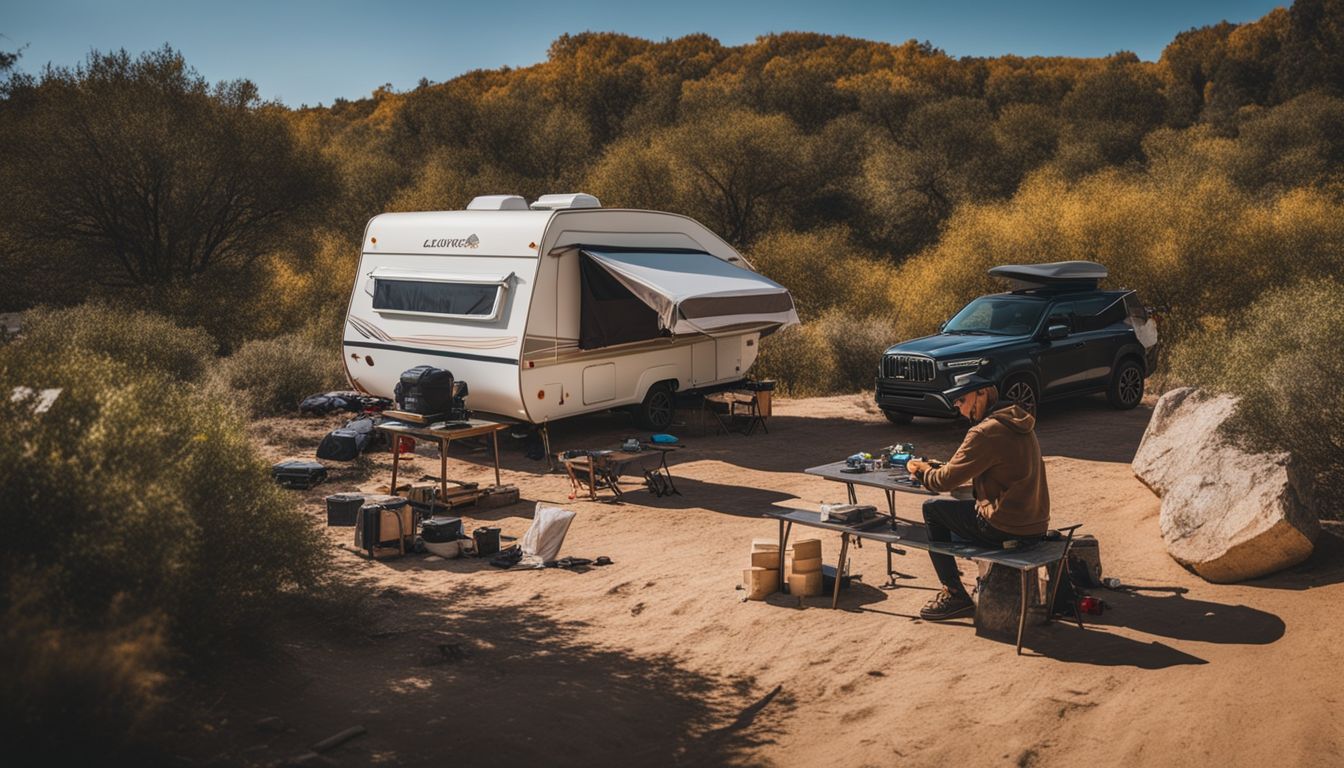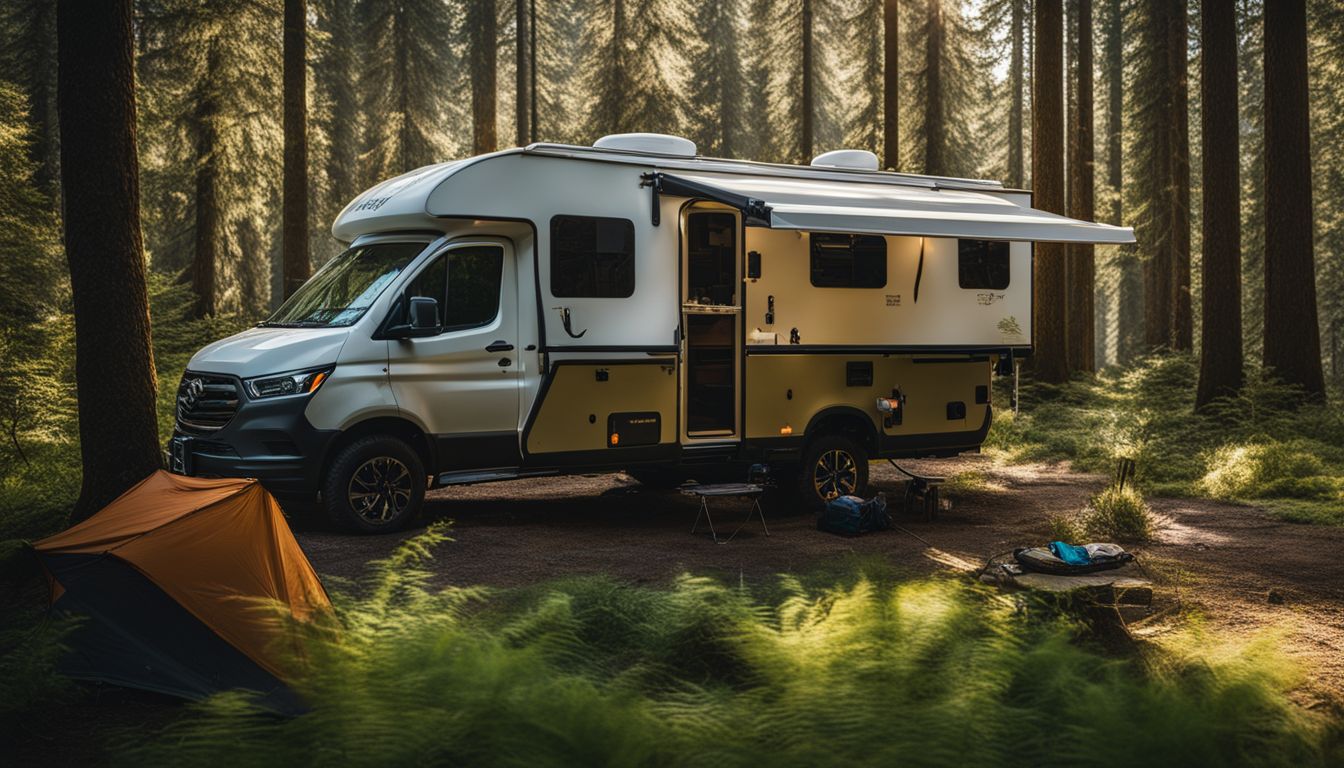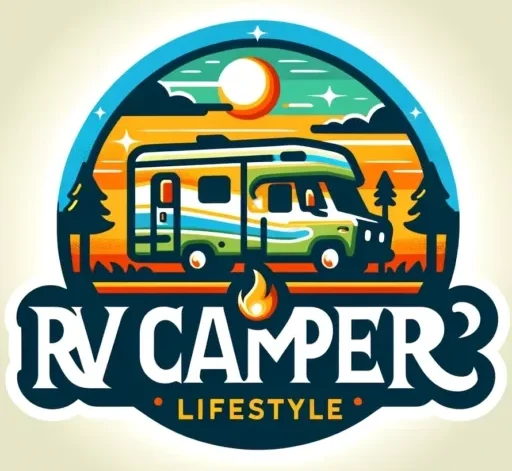How To Keep Your Camper From Rocking Side To Side: Effective Tips And Techniques
Few things disrupt a peaceful camping trip quite like a camper that won’t stop rocking side to side. Imagine setting up camp only to have your tranquility shaken by every move you make inside your travel trailer or fifth wheel.
This article is packed with effective tips and techniques guaranteed to keep your camper steady, ensuring you can enjoy all the comforts of home on the road without the wobble. Dive in for stabilization secrets that will transform your camping experience—peace of mind awaits!
Key Takeaways
- Level your camper on flat ground using leveling blocks and a bubble level to prevent tilting and rocking.
- Place wheel chocks snugly against the tires and use stabilizer jacks at each corner for secure support against movement.
- Keep things steady by spreading weight evenly inside the camper, with heavy items low and centered.
- Check tire pressure regularly since uneven pressure can cause instability.
- Invest in specific stabilizers like scissor jacks, hitch mounts, or a 5th Wheel King Pin Tripod based on your RV type for additional stability.
Related articles
Understanding the Causes of a Rocking Camper

Before we can effectively silence the unwanted dance of a camper in motion, it’s crucial to pinpoint what sets it swaying. It might stem from something as basic as tires settling or a bit more complex, involving ground conditions and load distribution—but knowing the root cause is your first step toward steadiness.
Resting on Tires
Leaving your camper just on its tires can cause a rocky feel. Tires are soft and bouncy, which means your RV will sway with every move you make inside. Even someone walking can start the shake.
Think of tires like balloons—they squish under weight and don’t hold things steady.
For a solid camp setup, use leveling blocks from Camco Heavy-Duty 10 pack to support those tires. They interlock, letting you build up just the right height for balance. This cuts down on that side-to-side wobble you hate so much.
And don’t forget wheel chocks! Place them snug against your wheels to keep your home-on-wheels still while parked. Your coffee won’t slide off the table now!
Unstable Ground
Unstable ground can turn a peaceful camping trip into a shaky annoyance. If your camper is parked on soft soil, grass, or gravel, it might not have the solid support it needs. This lack of stable footing means every move you make inside could cause the whole RV to wobble.
Think about when someone walks by and the entire camper sways—that’s unstable ground at work.
To fix this, make sure to find a hard surface for parking. Use leveling blocks to create a firm foundation under your tires and stabilizer jacks to keep everything steady. Keep in mind that proper tire pressure plays a big role too; uneven weight from low tires adds more shake to an already unsteady setup.
Always check your tire pressure before setting up camp—balanced tires help prevent rocking caused by the ground underneath you.
Uneven Terrain
Uneven terrain can make your camper wobble like a ship at sea. Your RV might be sitting on a slope, and that’s trouble for balance. Hills or dips in the ground push some tires harder against the earth than others.
This causes stress on your vehicle’s structure and affects how evenly it sits.
To fix this, you’ll need leveling jacks or blocks under your wheels. They act like little wedges that lift parts of your camper to match the rest of it with the ground level. It’s kind of like propping up one side of a wobbly table so it doesn’t rock when you use it.
With these tools, campers find their footing even when parked on bumpy land.
Overcrowding Inside the Camper
Too much stuff in your camper can cause a lot of shaking and wobbling. If you pack too many things, the weight inside might not be spread out evenly. This makes it uncomfortable to stay in there.
Not only that, but it’s also tough on the camper itself, making it less stable and balanced. It gets even harder when there’s no room to put things like stabilizer jacks or slide-out stabilizers properly.
Make sure your camper has enough space for everything and everyone. This helps keep your ride smooth and steady. When you’re piling in gear or gathering people inside, think about how it might throw off the balance.
Keep heavier items low and near the center to avoid tipping or bouncing around too much while you’re on the move or parked up for the night.
Tips and Techniques to Stabilize Your Camper

With the right approach, you can transform your camper into a serene retreat, free from the distraction of unexpected movements—explore our expert advice to achieve a perfectly stable home on wheels.
Proper Parking of Your Camper
Park your camper on stable, level ground to prevent rocking. Start by finding a spot that’s as flat as possible. Use a bubble level to see if the camper leans any direction. If it’s not level, grab some leveling blocks and stack them under the tires needing a boost.
Make sure each tire sits firmly on the blocks or on the ground. This will help distribute weight evenly and keep pressure off your tires. Uneven weight can make tires weak and lead to more bouncing inside your camper when you move around.
Always set parking brakes after positioning your RV to ensure it stays put.
Using Wheel Chocks
Put wheel chocks on both sides of your tires to keep your camper in place. These tools are vital because they stop rolling and bouncing. Make sure the chocks touch the tire’s surface tightly.
This way, your RV stays steady and secure.
Wheel chocks have a special design that supports the RV’s heavy frame from below. Slide them snugly against each wheel before you extend any stabilizer jacks or leveling blocks. Secure placement means less shaking inside when people move around or if there’s wind outside.
With these simple steps, you’ll enjoy a more stable and comfortable camping experience.
Utilizing Stabilizer Jacks
Stabilizer jacks are a must-have to keep your camper steady. You can find them at stores like eTrailer or online platforms. For example, the Set 4 LIBRA 9K lb Heavy Duty 24′ RV Trailer Camper Stabilizer Scissor Jacks are great for travel trailers and fifth wheels.
They work by firmly grounding each corner of your RV, cutting down on unwanted movement.
Make sure you place these jacks correctly for maximum stability. First, lower the stabilizing equipment until it touches the ground. Then adjust it so it’s tightly in place but not lifting your camper off its suspension.
This will prevent that annoying rocking side to side as people walk around or when strong winds blow. Slide-out stabilizers also add extra steadiness where you extend parts of your RV for more space.
Employing Leveling Blocks
Leveling blocks are a must when you’re setting up camp. They prevent your camper from leaning, which cuts down on rocking. You place them under the tires to make sure your RV sits flat, even on slopes or bumps.
For example, Camco Camper/RV Leveling Blocks cost $42.35 on Amazon Prime and they’re simple to use.
Imagine parking your home-on-wheels with confidence at every site! Just stack these durable blocks to the right height and drive your RV onto them for a firm footing. They’re tough enough to handle heavy rigs and they work like a charm every time you need that extra stability under your wheels.
Special Focus on Different Types of Stabilizers
Exploring the realm of stabilizers unveils a host of solutions designed to combat that unsettling sway; each type with its own unique merits. Whether you’re parked for the night or setting up for an extended stay, matching your camper with the right stabilization system is key to achieving that solid, immovable feel underfoot.
Scissor Jack Stabilizer
Scissor Jack Stabilizers are a smart choice for stopping your camper from swaying side to side. They’re sturdy and easy to use. With different types, you can find the perfect fit for your RV needs.
For example, slide-out stabilizers give extra support when your camper’s slide-outs are extended.
Using a scissor jack is simple. A cordless drill can turn the screw drive fast, making setup quick and easy. BAL X-Chocks work great if you’ve got an RV with dual axles—they fit snugly between wheels to keep things steady.
No matter which type of scissor jack stabilizer you choose, they’ll make sure your home on wheels stays put without wobble or sway.
Hitch Mount Stabilizer
Hitch mount stabilizers clamp onto the hitch of your trailer. They act like strong arms that keep your camper steady. Think of them as the muscles that hold everything tight so your home on wheels doesn’t sway back and forth.
These stabilizers are great because they’re easy to use. You attach them and adjust until things feel solid.
RV owners love hitch mount stabilizers for their simplicity and strength. They cut down the side-to-side shaking you feel inside your camper. When you’re out there in nature, peace of mind comes from knowing your RV won’t rock with every move you make or gust of wind that blows.
Hitch mounts give you that security, so you can relax and enjoy your adventure without worrying about a wobbly camper.
5th Wheel King Pin Tripod
A 5th Wheel King Pin Tripod can be a game changer for your fifth wheel RV. It tackles that annoying side to side sway with ease. Just place it under the king pin, and you’ll feel like your RV is resting on solid rock, even if the ground isn’t! This trusty tool takes a load off your landing gear too.
That means less wear and tear over time.
With the tripod in position, movements inside the camper won’t cause as much rocking. You can walk around or roll over in bed without feeling like you’re on a boat. It’s perfect for setups on soft or uneven terrain where extra support is needed.
So remember, before you kick back and relax in your parked camper, make sure to set up that sturdy tripod—it’s a simple step toward stability and peace of mind!
Slide-Out Stabilizers
Slide-out stabilizers are your best friends when you extend your RV’s slide-outs. They add extra support, stopping the wobble and sway that can make your mobile home feel unsteady.
Just like a kickstand on a bike, they keep everything balanced. You set them up under each slide-out corner to stop the bounce as people move around inside.
These stabilizers work hard to give you peace of mind while you’re enjoying the extra space in your camper. It’s important not to overload them though; their job is to prevent movement, not lift the RV! Make sure they’re snug but not pushing up too strongly against your slide-outs.
With these buddies in place, you’ll hardly feel any shaking—even when someone’s walking about or if it’s windy outside.
X-Chocks
X-Chocks give your camper rock-solid stability. You slide them between the tires on dual-axle RVs. Once in place, they push outward against each wheel for strong support. This prevents annoying side-to-side movements especially when you’re moving around inside.
Your camper’s slide-out sections need extra care too. X-Chocks help by keeping everything steady while these parts are extended. They come with a wrench and can also work with a cordless drill to make setting up quick and easy.
Just extend the chock to fit snugly between wheels and enjoy a more stable home away from home.
Preventing Side-to-Side, Back-and-Forth, and Up-and-Down Motions
Your camper rocks and sways because it’s not properly stabilized. Stabilizing your RV is key to a smooth camping experience.
- Start with level ground. Find a spot that’s flat to prevent your camper from tilting.
- Use wheel chocks. Place them snugly against the tires on both sides to keep the camper from moving.
- Stabilizer jacks are crucial. Set them at all four corners of your RV for solid support.
- Try leveling blocks if the ground is uneven. Build them up like a ramp for your tires to sit level.
- Install slide-out stabilizers under each slide-out section. This supports the extra weight when they’re extended.
- Employ RV step stabilizers to stop wobbling when entering or leaving the camper.
- Consider a hitch mount stabilizer for towable campers. Attach it to reduce bounce during windy conditions.
- Secure a 5th wheel king pin tripod under the front hitch. It steadies the front end well.
- Tighten X – Chocks between tandem tires. They apply pressure to prevent tire shifting and movement.
The Importance of Stabilizing Your Camper
Keeping your camper steady is key to a great trip. A shaky RV can ruin sleep and make daily activities hard. It also protects the structure of your RV from damage caused by constant movement.
Think about how you feel on a boat in rough water – that’s not what you want in your camper!
Stabilizing reduces wear on all parts of the RV, especially slide-outs and appliances. Secure campers are safe campers too; they’re less likely to tip over or be affected by strong winds.
So stability means more fun, less stress, and longer life for your home-on-wheels!
Conclusion
Stabilizing your camper is easy with the right tools and know-how. Use wheel chocks, leveling blocks, and stabilizer jacks to keep things steady. Choose the best type of stabilizer for your needs—scissor jacks or a tripod for 5th wheels work great.
Remember, a stable camper means more comfort and less worry about rocking motions. Get set up properly to enjoy peaceful camping every time!
FAQs
1. What are slide-out stabilizers, and can they stop my camper from rocking?
Slide-out stabilizers are strong supports that you place under the slide-out sections of your camper. Yes, they can really help keep your camper steady and prevent it from rocking.
2. Can I learn how to use these stabilizers by watching a YouTube channel?
Absolutely! There are many YouTube channels where experts show you how to install and use slide-out stabilizers – just find one that’s easy for you to follow.
3. Are there any affiliate programs for products like slide-out stabilizers?
Yes, there certainly are! Some companies offer affiliate programs where if you recommend their products, like utility trailers or camper accessories, they’ll pay you a commission.
4. Should I join an affiliate program if I talk about campers on my blog or channel?
If you’re giving people advice on camping gear and have followers who trust what you say – joining an affiliate program could be a great idea; just always remember to let them know about the partnership!







